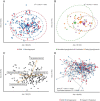Gestational diabetes and the human salivary microbiota: a longitudinal study during pregnancy and postpartum
- PMID: 32005194
- PMCID: PMC6995204
- DOI: 10.1186/s12884-020-2764-y
Gestational diabetes and the human salivary microbiota: a longitudinal study during pregnancy and postpartum
Abstract
Background: An aberrant composition of the salivary microbiota has been found in individuals with type 2 diabetes, and in pregnant women salivary microbiota composition has been associated with preeclampsia and pre-term birth. Pregnant women, who develop gestational diabetes (GDM), have a high risk of developing type 2 diabetes after pregnancy. In the present study we assessed whether GDM is linked to variation in the oral microbial community by examining the diversity and composition of the salivary microbiota.
Method: In this observational study the salivary microbiota of pregnant women with GDM (n = 50) and normal glucose regulation (n = 160) in third trimester and 9 months postpartum was assessed by 16S rRNA gene amplicon sequencing of the V1-V3 region. GDM was diagnosed in accordance with the International Association of the Diabetes and Pregnancy Study Groups (IADPSG) criteria. Cross-sectional difference in alpha diversity was assessed using Student's t-test and longitudinal changes were assessed by mixed linear regression. Cross-sectional and longitudinal difference in beta diversity was assessed by permutational multivariate analyses of variance. Differentially abundant genera and OTUs were identified by negative binomial regression.
Results: In the third trimester, two species-level operational taxonomic units (OTUs), while eight OTUs postpartum were differentially abundant in women with GDM compared with normoglycaemic women. OTU richness, Shannon diversity and Pielou evenness decreased from late pregnancy to 9 months after delivery regardless of glycaemic status.
Conclusion: GDM is associated with a minor aberration of the salivary microbiota during late pregnancy and postpartum. For unknown reasons richness of the salivary microbiota decreased from late pregnancy to postpartum, which might be explained by the physiological changes of the immune system during human pregnancy.
Keywords: Bacterial species; Gestational diabetes mellitus; Gestational hyperglycaemia; Glycaemic traits; Pregnancy; Salivary microbiota.
Conflict of interest statement
The authors declare that they have no competing interests.
Figures




Similar articles
-
Gestational diabetes is associated with change in the gut microbiota composition in third trimester of pregnancy and postpartum.Microbiome. 2018 May 15;6(1):89. doi: 10.1186/s40168-018-0472-x. Microbiome. 2018. PMID: 29764499 Free PMC article.
-
Comparative Studies of the Gut Microbiota in the Offspring of Mothers With and Without Gestational Diabetes.Front Cell Infect Microbiol. 2020 Oct 23;10:536282. doi: 10.3389/fcimb.2020.536282. eCollection 2020. Front Cell Infect Microbiol. 2020. PMID: 33194786 Free PMC article.
-
Gut microbiota in pregnant Malaysian women: a comparison between trimesters, body mass index and gestational diabetes status.BMC Pregnancy Childbirth. 2022 Feb 24;22(1):152. doi: 10.1186/s12884-022-04472-x. BMC Pregnancy Childbirth. 2022. PMID: 35209853 Free PMC article.
-
Characteristics of the gut microbiome in women with gestational diabetes mellitus: A systematic review.PLoS One. 2022 Jan 13;17(1):e0262618. doi: 10.1371/journal.pone.0262618. eCollection 2022. PLoS One. 2022. PMID: 35025980 Free PMC article.
-
[Gestational diabetes mellitus (Update 2019)].Wien Klin Wochenschr. 2019 May;131(Suppl 1):91-102. doi: 10.1007/s00508-018-1419-8. Wien Klin Wochenschr. 2019. PMID: 30980150 Review. German.
Cited by
-
Gestational gut microbial remodeling is impaired in a rat model of preeclampsia superimposed on chronic hypertension.Physiol Genomics. 2021 Mar 1;53(3):125-136. doi: 10.1152/physiolgenomics.00121.2020. Epub 2021 Jan 25. Physiol Genomics. 2021. PMID: 33491590 Free PMC article.
-
Metabarcoding analysis of oral microbiome during pregnancy.Front Cell Infect Microbiol. 2024 Dec 17;14:1477703. doi: 10.3389/fcimb.2024.1477703. eCollection 2024. Front Cell Infect Microbiol. 2024. PMID: 39742335 Free PMC article.
-
Bridging the gap between omics research and dental practice.BDJ Open. 2024 Mar 4;10(1):16. doi: 10.1038/s41405-024-00199-3. BDJ Open. 2024. PMID: 38438363 Free PMC article. Review.
-
Oral microflora and pregnancy: a systematic review and meta-analysis.Sci Rep. 2021 Aug 19;11(1):16870. doi: 10.1038/s41598-021-96495-1. Sci Rep. 2021. PMID: 34413437 Free PMC article.
-
Leveraging Dental Stem Cells for Oral Health during Pregnancy: A Concise Review.Dent J (Basel). 2024 May 7;12(5):127. doi: 10.3390/dj12050127. Dent J (Basel). 2024. PMID: 38786525 Free PMC article. Review.
References
Publication types
MeSH terms
Substances
Grants and funding
LinkOut - more resources
Full Text Sources
Medical

